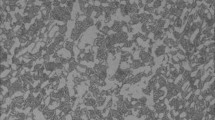Abstract
In order to develop a new titanium alloy with a good combination of strength–ductility–toughness, a near-beta titanium alloy was designed based on the already widely used Ti-1023 alloy. To avoid beta fleck occurring in the microstructure, the new Ti–Al–Fe–V (Cr, Zr) alloy has been made through decreasing the content of Fe, based on molybdenum equivalency and Bo–Md molecular orbital method (a method for new alloy designing based on the molecular orbital calculating). After primary design computation, Ti–Al–Fe–V (Cr, Zr) alloy was optimized as Ti–3Al–4.5Cr–1Fe–4V–1Zr finally. The microstructure and tensile properties of this alloy subjected to several commonly used heat treatments were investigated. The results show that the tensile strength of the alloy after solution treated below the β-transus temperature comes between 850 and 1100 MPa, with elongation in the range of 12.5 %–17.0 %. In solution-treated and solution-aged samples, a low-temperature aging at 500 °C results in the precipitation of finer α phase. With the increase in aging temperature, the secondary α phase becomes coarser and decreases in amount. Thus, it will lead to the increase in tensile ductility, but reduction in strength. Eventually, after modulated aging treatment, the alloy can obtain high-strength level with acceptable ductility. The tensile strength of the alloy can achieve 1273 MPa, with an elongation of 11.0 %. At the same time, the fracture toughness (K IC) of the alloy achieves 83.8 MPa·m1/2. It is obvious that the newly designed alloy has achieved a good blend of strength–ductility–toughness.







Similar content being viewed by others
References
Boyer RR. An overview on the use of titanium in the aerospace industry. Mater Sci Eng A. 1996;213(1–2):103.
Fei YH, Zhou L, Qu HL, Zhao YQ, Huang CZ. The phase and microstructure of TC21 alloy. Mater Sci Eng A. 2008;494(1–2):166.
Duerig TW, Williams JC. Overview: microstructure and properties of beta-titanium. In: Proceedings of the Beta Titanium Alloys in the 1980s. Warrendale; 1984. 20.
Weiss I, Semiatin SL. Thermo-mechanical processing of beta titanium alloys—an overview. Mater Sci Eng A. 1998;243(1–2):46.
Koike J, Maruyama K. Study of primary creep in Ti–6–22–22S alloys. Mater Sci Eng A. 1999;263(2):155.
Chen CC, Boyer RR. Practical considerations for manufacturing high strength Ti–10V–2Fe–3Al forgings. J Metals. 1979;31(7):33.
Yue Q, Liu YQ, Wang DC, Wang XZ, Chu MY, Shen JY. Effects of microstructures on mechanical properties of Ti-63 titanium alloy. Rare Met. 2009;28(6):533.
Zhou ZB, Fei Y, Lai MJ, Kou HC, Chang H, Shang GQ, Zhu ZS, Li JS, Zhou L. Microstructure and mechanical properties of new metastable β type titanium alloy. Trans Nonferrous Metals. 2010;20(12):2253.
Prima F, Vermaut P, Ansel D, Debuigne J. ω precipitation in a beta metastable titanium alloy, resistometric study. Mater Trans JIM. 2000;41(8):1092.
Dobromyslov AV, Elkin VA. Martensitic transformation and metastable β phase in binary titanium alloys with d-metals of 4–6 periods. Scr Mater. 2001;44(6):905.
Kar SK. Modeling of Mechanical Properties in Alpha/Beta-Titanium Alloys. Ohio: The Ohio State University; 2005. 14.
Lenain A, Clement N, Jacques PJ. Characterization of the α phase nucleation in a two-phase metastable β titanium alloy. J Mater Eng Perform. 2005;14(6):722.
Azimzadeh S, Rack HJ. Phase transformations in Ti–6.8Mo–4.5Fe–1.5Al. Metall Mater Trans A. 1998;29(10):2455.
Terlinde GT, Duerig TW, Williams JC. The effect of heat treatment on microstructure and tensile properties of Ti–10V–2Fe–3Al. In: Proceedings of the 4th Int’l Conference on Titanium. Fremont; 1980. 1573.
Terlinde G, Rathjen HJ, Schwalbe KH. Microstructure and fracture toughness of the aged β-Ti alloy Ti–10V–2Fe. Metall Mater Trans A. 1988;19(4):1037.
Acknowledgments
This project was financially supported by the National and International Scientific and Technological Cooperation Special Funded Project (No. 2013DFG52920).
Author information
Authors and Affiliations
Corresponding author
Rights and permissions
About this article
Cite this article
Li, D., Hui, SX., Ye, WJ. et al. Microstructure and mechanical properties of a new high-strength and high-toughness titanium alloy. Rare Met. 42, 281–287 (2023). https://doi.org/10.1007/s12598-016-0722-7
Received:
Revised:
Accepted:
Published:
Issue Date:
DOI: https://doi.org/10.1007/s12598-016-0722-7




